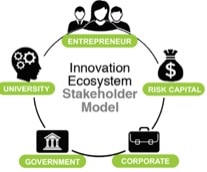At a time of rapid economic and technological change, the places that will be successful in the knowledge economy are those that can create and commercialise innovation.
The opportunity is to spin out and diffuse research and knowledge from universities and other knowledge intensive anchor institutions, such as teaching hospitals or major cultural bodies. By doing so places can support the start-up and scaling-up of more of the fast-growing, innovation-driven, high-export firms that are so important to rapid productivity growth.
One of the causes of the relative economic underperformance of many of the UK’s cities and city regions outside the London-Oxford-Cambridge “golden triangle” is that, despite having strong universities and some real success stories, they have yet to build an innovation-led-economy with sufficient strength, coherence and critical mass.
Greater Boston, Massachusetts has built one of the world’s most dynamic and successful economies based on innovation, anchored by the Massachusetts Institute of Technology (MIT) and other world class universities.
The MIT motto is “mans et manus”: hands and head working in tandem to provide real-world solutions. In the UK the role of universities as anchor institutions has been brought into focus by the development of local industrial strategies; the excellent UPP Civic University Commission and the need to demonstrate real-world impact on research and knowledge exchange through the Research Excellence and Knowledge Exchange Frameworks. While we see this civic mission now featuring more prominently at the head of many university strategies alongside excellent teaching; research and international profile, universities are still grappling with how they put it at the heart of what they do.
Building shared vision and purpose
The question often asked is why the Greater Boston economy is so successful and how does MIT act as such a significant economic catalyst? The answer provides lessons for all parts of the UK. MIT, through its Regional Entrepreneurship Acceleration Programme (REAP) framework, has identified the components of a successful ecosystem for innovation-led growth.
Is it too fanciful for us to imagine an MIT of the North: a vibrant innovation driven eco-system?
Initiated and led by the University of Leeds as the cohort Champion, this is the challenge that the MIT REAP Leeds team have picked as part of a global cohort going through a two-year journey as part of the programme.
A strong base of research intensive universities is important. There needs to be a sufficient number of entrepreneurs with the right skills and culture (and MIT believes strongly that entrepreneurship can be taught) to spin-out, start and scale up innovative firms. A strong group of corporates undertaking innovation and supporting and advising smaller firms is necessary. The availability of risk capital and the engagement of angel investors, who provide mentoring and advice, as well as finance, to entrepreneurs is a major factor. Local and national government has a major role to play in creating the right policy frameworks, infrastructure, and data.
All these actors need to work together to ensure there is the right engagement and support across the system to create a successful ecosystem that is more than the sum of its constituent parts. This stakeholder model sits at the core of the MIT approach (illustrated in the diagram below).

Representing KPMG and Arup, we are the “corporate” part of the system for MIT REAP Team Leeds. For us, and for all of the Leeds team – made up of senior members from each stakeholder group from across the city – living the stakeholder model has been a core differentiator from what has gone before. Though initiated by the university we are all seen as equal players in the system each of whom brings a different lens to bear on the issues we are facing. The university has been the catalyst, but is seen as a part of the answer, not the whole solution.
We have a developing sense of a shared vision: we have worked hard to understand the Leeds eco-system together from a quantitative and qualitative evidence base; we have really questioned our assumed comparative advantages; we have discussed and argued our perspectives in an environment that enables robust discussion and disagreement and, fuelled by our joint analysis of the situation, twelve months in, we are developing a real sense of collective purpose.
Lessons for the UK
If the MIT REAP process does provide a blueprint, then our emerging observations are that there are four important implications here for UK cities and regions, and for the universities located within them.
First, a place-based approach is important. The MIT story demonstrates the importance of the components for innovation coming together in a geographical place. The modern economy relies on intangible assets and networks such as knowledge, research and development, creativity, software, data, and talent. Interconnected industries are growing, and the boundaries between sectors such as finance, digital, services, design, engineering, health and so on are becoming increasingly blurred. This means that knowledge spillovers between them are critical to the economic competitiveness of places.
For universities, who tend to start from a position of the strength of their own research base, true interdisciplinary working will become even more critical, perhaps more so outside the university than within it. The scale and density of knowledge transfers can be maximised in cities and connected districts which can support a critical mass and high densities of face-to-face contacts between knowledge-intensive firms, workers, and institutions. However, most policy and funding decisions for innovation in the UK are taken at national level and in silos relating to specific sectors. Universities need to be vocal advocates of the need to build on the local industrial strategy to move to a more place-based approach with greater devolution of funding.
Second, innovation districts in city centres and connected urban districts are emerging as the places that can help UK cities create, scale-up and attract the fast-growing firms, new products and processes which will drive more productive and inclusive economic growth. The geography of innovation and the economy is changing. Knowledge intensive jobs are moving back into urbanareas where skilled and creative workers, innovative firms, researchers from universities and other institutions, healthcare clinicians, investors and entrepreneurs are sharing knowledge and ideas in collaborative spaces and networks.
Cities, universities and other anchor institutions for innovation should seek to support and capitalise on this trend through bold investments to create new campuses, business space, and public realm. These are the science parks of the twenty-first century: regeneration hotspots, magnets for inward investment, and places that can change our economy. We would question any university plan that sought to establish an innovation centre in isolation from the other players.
Third, there needs to be a stronger focus on building the networks for collaboration to develop more successful innovation-driven entrepreneurial ecosystems. This might include creating accelerator programmes to ensure entrepreneurs can access the research, mentoring and advice to commercialise ideas (or fail fast), and the investment, markets and premises they need to succeed.
There is scope to build on the work of the Scale-Up Institute to provide more support to fast-growing scale-up firms. In some places there is a need to improve access to risk capital through initiatives such as NorthInvest which is building a network of angel investors and connecting them to start-ups.
For universities considering how they can play a stronger catalytic role in growing the economy as part of their civic purpose, this could include increasing entrepreneurial education and staff and student entrepreneurship and industry collaboration. But bolting on innovation and collaboration to the university’s strategy is not enough. Leaders need to review in detail how the different parts of the university interact with each other on innovation to ensure the right structures, people and incentives are in place to encourage, what might be for some, a very different approach.
There is potential for places to stimulate and bring together innovation activity around missions, aimed at solving societal challenges, as recommended by the UCL Commission for a Mission-orientated Approach to Industrial Strategy. This is one of the emerging strategic interventions we are considering in Leeds that also strikes the right balance for us on achieving inclusive economic growth.
Finally, tackling the significant regional imbalances in research and development funding will be needed as part of the government’s aim to increase research and development investment to 2.4 per cent of GDP. Public sector research and development investment has a key role in stimulating private sector research and development activity but currently there are significant regional disparities in this investment.
Join in
As Roger Marsh, Chair of the NP11 group of Local Enterprise Partnerships, and part of the MIT REAP team, said recently: “creating ideas costs money, it is only by commercialising those ideas that we can make money and create wealth.”
We need more places in the UK to build strong innovation-driven and entrepreneurial economies. That will require a place-based approach, more support for the development of innovation districts, a stronger focus on building the networks for collaboration between innovators, entrepreneurs and other actors in the ecosystem, and it needs a concerted effort to increase, and tackle the imbalances in, research and development investment.
As drivers of innovation and ideas, the role of universities is critical, but they cannot act alone and need to build their own stakeholder teams if civic mission is to be at the heart of their strategy, not just the headline.














There are other factors which have led to the support for innovation around the Boston region. MIT has an endowment fund of $17.4bn, it’s neighbour, Harvard, has an endowment fund of $40.9bn. Thus home institution funding for university spin outs can be much more substantial and longer term than available to UK spin outs. Only Oxford and Cambridge have comparable endowments of around £6bn each. This may help explain why the golden triangle exists. Many of the firms in the Boston region are long established life science and computing companies which can trace their origins back to a handful of… Read more »
Very valid points Glenwyn So how do places address the relative disadvantages of having much lower levels of funding available through their University systems, if indeed they have Universities at all? And how does this group, the LEP’s and society generally help politicians deal with the relatively poor levels of political leadership at a local level by encouraging effective long term planning and the delivery of robust dynamic local visions? Perhaps some of the answers lie in: 1. further mobilising risk capital through the corporate systems and organisations with a vested interest in places. LGIM seem to be one of… Read more »
An MIT of the north is something i have been arguing for for over 30 years so pleased its become a possibility. I think it has to play out as a long game as we need to get all the elements right. WE need to establish a first rate institution in a lovely setting with in the main traditional looking achitecture to attract the brightest and best. I would suggest moving some top departments there from other universities to get things moving but not sure how easy that is to do. The economic spin offs will come down the track… Read more »